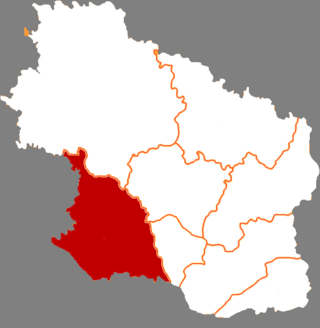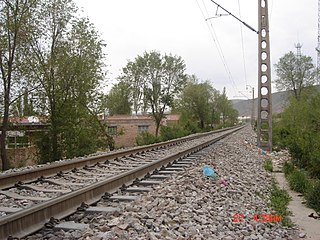Related Research Articles

The Western Qin was a dynastic state of China ruled by the Qifu clan of Xianbei ethnicity during the era of Sixteen Kingdoms. All rulers of the Western Qin declared themselves "wang",translatable as either "king" or "prince." They ruled an area corresponding to modern-day southwestern Gansu in Northwest China.

Tianshui is a prefecture-level city in Gansu province,China,and is the province's second-largest city. Located in the southeast of the province,the city strides along the upper reaches of the Wei River and at the boundary of the Loess Plateau and the Qinling Mountains. As of the 2020 census,its population was 2,984,659 inhabitants,of which 1,212,791 lived in the built-up area made of the 2 urban districts of Qinzhou and Maiji. The city and its surroundings have played an important role in the early history of China,as still visible in the form of historic sites such as the Maijishan Grottoes.

Mount Liupan is a mountain range in northwestern China,located mostly in southern Ningxia Hui Autonomous Region. It marks the southwestern boundary of the Ordos Basin.

Pingliang is a prefecture-level city in eastern Gansu province,China,bordering Shaanxi province to the south and east and the Ningxia Hui Autonomous Region to the north. The city was established in 376 AD. It has a residential population of 2,125,300 in 2019. The urban population is almost 900,000.

Qingyang is a prefecture-level city in eastern Gansu province,China.
Helian Chang,courtesy name Huanguo (還國),nickname Zhe (折),was the second and penultimate emperor of the Hu Xia dynasty of China. He was the successor and a son of the founding emperor Helian Bobo. After his father's death in 425,he tried to expand Hu Xia's territory further,but soon his state began to collapse in light of pressure from the rival Northern Wei dynasty. In 427,his capital Tongwan fell to Northern Wei forces,and in 428 he himself was captured. The Emperor Taiwu of Northern Wei did not kill him but instead treated him as an honored companion,marrying a sister to him and creating him high titles—initially the Duke of Kuaiji (會稽侯) and later the Prince of Qin (秦王)—but in 434,he tried to escape and was killed.
Helian Ding,nickname Zhifen (直獖),was the third and last emperor of the Xiongnu-led Chinese Hu Xia dynasty. He was a son of the founding emperor Helian Bobo and a younger brother of his predecessor Helian Chang. After Helian Chang was captured by rival Northern Wei's army in 428,Helian Ding took the throne himself and for several years tried to resist Northern Wei attacks,but by 430 he had lost nearly his entire territory. In 431,he attempted to head west to try to attack Northern Liang and seize its territory,but on the way,he was intercepted by Tuyuhun's khan Murong Mugui (慕容慕璝) and captured,ending Hu Xia. In 432,Murong Mugui turned him over to the Emperor Taiwu of Northern Wei,who had him executed.

Zhuanglang County is a rural county under the administration of the prefecture-level city of Pingliang in the east of Gansu Province,China. It borders Ningxia to the north,the Gansu county-level divisions of Huating City to the east,Zhangjiachuan County to the southeast,Qin'an County to the southwest,and Jingning County to the west. Nearby major cities include Pingliang,Tianshui,Guyuan,and Lanzhou.

Jingchuan County is a county under jurisdiction of the prefecture-level city of Pingliang,in the east of Gansu Province,China,bordering Shaanxi Province to the southeast. It has a land area of 1,486 square kilometers. The county is named after the Jing River. In 2020 it had a population of 356,200,over 300,000 of whom in the rural area.

Jingyuan County is a county in the east of Gansu Province. It is under the administration of Baiyin City,and consists of two separate tracts of territory to the north and south of Pingchuan District. The northern tract borders Ningxia to the north. The southern area consists of an irrigated area around the Yellow River and the northern area is semi-arid highlands.

Zhenyuan County is a county in the east of Gansu province,China,bordering Ningxia to the west. It is under the administration of the prefecture-level city of Qingyang. Its postal code is 744500,and its population in 2018 was 528,076 people.

Kongtong is a district of the city of Pingliang,Gansu province,China,bordering Ningxia to the northwest. It is named after the Kongtong Mountains. Kongtong is the seat of Pingliang city's government. At the start of 2021 the population was 534,800,65% living in the urban area.
Huating is a county-level city,formerly Huating County,in the east of Gansu province,China,bordering Ningxia to the northwest. It is under the administration of the Pingliang City. Its postal code is 744100,and in 1999 its population was 176,941 people.
The Sixteen Kingdoms,less commonly the Sixteen States,was a chaotic period in Chinese history from AD 304 to 439 when northern China fragmented into a series of short-lived dynastic states. The majority of these states were founded by the "Five Barbarians",non-Han peoples who had settled in northern and western China during the preceding centuries,and had launched a series of rebellions against the Western Jin dynasty in the early 4th century. However,several of the states were founded by the Han people,and all of the states—whether ruled by Xiongnu,Xianbei,Di,Jie,Qiang,Han,or others—took on Han-style dynastic names. The states frequently fought against both one another and the Eastern Jin dynasty,which succeeded the Western Jin in 317 and ruled southern China. The period ended with the unification of northern China in 439 by the Northern Wei,a dynasty established by the Xianbei Tuoba clan. This occurred 19 years after the Eastern Jin collapsed in 420,and was replaced by the Liu Song dynasty. Following the unification of the north by Northern Wei,the Northern and Southern dynasties era of Chinese history began.

Ejin is a banner in the far west of Inner Mongolia,China. It is under the administration of Alxa League and is the westernmost county-level division of Inner Mongolia,bordering Gansu province to the west and Mongolia's Bayankhongor and Govi-Altai Provinces. Its seat is located at Dalaihob Town. To the west,it shares a border with Subei Mongol Autonomous County of Jiuquan,Gansu.

The Ordos Plateau,also known as the Ordos Basin or simply the Ordos,is a highland sedimentary basin in parts of most Northern China with an elevation of 1,000–1,600 m (3,300–5,200 ft),and consisting mostly of land enclosed by the Ordos Loop,a large northerly rectangular bend of the Yellow River. It is China's second largest sedimentary basin with a total area of 370,000 km2 (140,000 sq mi),and includes territories from five provinces,namely Shaanxi,Gansu,Ningxia,Inner Mongolia and a thin fringe of Shanxi,but is demographically dominated by the former three,hence is also called the Shaan-Gan-Ning Basin. The basin is bounded in the east by the Lüliang Mountains,north by the Yin Mountains,west by the Helan Mountains,and south by the Huanglong Mountains,Meridian Ridge and Liupan Mountains.
Fengzhou or Feng Prefecture (鳳州) was a zhou (prefecture) in imperial China,centering on modern Feng County,Shaanxi,China. It was created in 554 by Western Wei and existed (intermittently) until 1374 during the Ming dynasty.
Wuzhou,or Wu Prefecture (武州),was a zhou (prefecture) in imperial China. It is in the border area of what is now southern Ningxia and Gansu,China. It was abolished in 958 under Later Zhou.
Jingzhou or Jing Prefecture (涇州) was a zhou (prefecture) in imperial China,centering on modern Jingchuan County,Gansu,China. It was created in the 5th century by Northern Wei and existed (intermittently) until 1913 after the establishment of the Republic of China.

The Baoji–Zhongwei railway is a railway line in northwest China:it starts in Baoji in Shaanxi,passes through Pingliang in Gansu and finally ends in Zhenluobao (镇罗堡) in Zhongwei in Ningxia,with a total length of 498.19 kilometres. Construction on the railway started in 1990 and track laying was completed on 10 July 1994. It was electrified and opened in the following year on 8 June 1995. The railway is under the jurisdiction of the Xi'an Railway Bureau in Shaanxi and the Lanzhou Railway Bureau in Gansu and Ningxia. The line is single-track and electrified. It is a key line connecting Shaanxi,Gansu and Ningxia.
References
- Shi Weile, ed. (2005). Zhongguo Lishi Diming Da Cidian (中国历史地名大词典)[Large Dictionary of Chinese Historical Place Names] (in Chinese). China Social Sciences Press. p. 2615. ISBN 7-5004-4929-1.